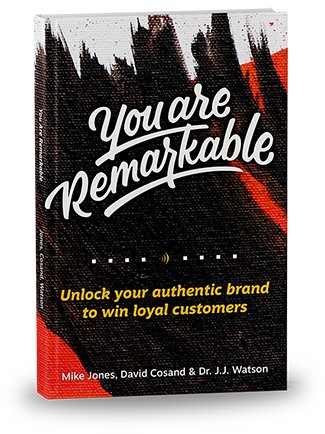Podcast: Play in new window | Download
Subscribe: RSS
Tech innovations, like AI, come along every few years. The real question is, how will you leverage it—understanding the advantages and disadvantages of AI—to elevate your performance?
AI improves automation and efficiency. It can analyze data, generate content, and even interact with customers. And it’s tough for humans to match the speed and cost.
But ultimately, AI only replaces you for routine and repetitive marketing tasks. Maybe it’s time we talk about all its shortcomings, and what you can do to rise above yet another “disruptive” technology innovation.
I talked with Anait Zubia, former marketing manager at Quora, about how she sees AI, and these insights came from that discussion.
Let’s cover a few things AI’s not very good at and a third piece of advice for how to put it to work, pushing your career forward.
You Dictate the Why: Measuring AI against real marketing objectives.
For all of the benefits of AI, it doesn’t know how to create objectives, strategies, or even executions for your brand without your help.
AI isn’t a project manager. You decide where AI fits in the process and what you expect it to do. Like any tool in your stack, keep it simple and build from there.
AI isn’t a brand manager. It may understand your color scheme, but it doesn’t know how to connect with people. Your brand needs to do that. It can do a lot of work, but it needs accountability. This is where you put your brand manager hat on.
AI isn’t a leader. Leaders make moral decisions. Sure, we think of leadership as everything from strategists to theorists who help us understand practical ways to get from here to there. But at their base, we expect leaders to be moral actors. It’s a prerequisite (except, apparently, in politics). The bottom line is that marketing leaders are still needed to make sure that what we do—and how we communicate—is moral, not just expedient.
AI is not a replacement. It’s a support. It’s a tool, not a worker. But if you think about it the right way, it can free you up for other things. For example, the time you’re saving from writing a blog outline could be spent reading about leadership, or even walking around the office, exercising leadership by encouraging, problem-solving and helping others make good decisions and get work done.
Leaders bring a sense of order and brand to the work. AI is just a tool that can help you execute. Leaders should view AI as a tool to enhance, not replace, human capabilities, allowing them to tackle more significant challenges in an AI-augmented world.
The Dangers of Blind AI Trust
For brands, we’re bringing a point of view to the areas we speak to. Your ability to evaluate and respond to new trends based on your brand makes your content interesting and gives it depth. But if you rely on AI to speak into your topics before you get a chance to analyze them, you may lose your edge, creating content that’s predictable and not valuable to your audience.
Refresher: How Point of View Works in Creativity.
Students of the creative process know there’s a thing called “top-down” thinking, which refers to your ability to form an opinion and dig into a topic before you start receiving information about it from outside sources.
This gives your content originality.
By forming an opinion based on your values first, you’re creating thought leadership in a way that makes sense, unpolluted by the complicated and often-convoluted thoughts of others…or the oft-misapprehended outputs of AI.
This is especially true with political topics.
AI is likely to take an inoffensive approach, which sometimes puts politeness over truth. So if your brand takes a truth-first approach—as part of its values—to making sense of topics, you’ll find AI lacking.
The goal is not “diversity” or “homogeneity.” Rather, it’s helping people make sense of the world, and business, from your brand’s point of view. So as we’re taking our mom’s advice and “considering the source,” we also need to determine what points of view are valid and which aren’t.
It sounds exclusive. It sounds closed-minded. It’s called “standing for something.”
Use AI only AFTER you’ve thought it through.
AI may default to answering questions it thinks are mainstream (I’ve even had it give me values judgments I didn’t ask for when asking a technical question), but it also is trained on less-popular viewpoints as well. This gives you the opportunity to ask about the topic as if you’re arguing with someone from a different point of view. This creates some very original content—pulling you deeper into the topic—that your audience is likely to find interesting and useful.
Examples of AI bias:
- Social Media Feeds: AI algorithms curate content based on broad user preferences and the goals of the media channel. Do your brand’s goals always match with the average person or the views or business goals of the channel?
- News Aggregation: AI-driven news apps may prioritize or deprioritize what they see as sensational or biased content. This represents bias since not everyone agrees on what “bias” or “sensational” means.
- Search Engines: Search algorithms can create filter bubbles, limiting exposure to alternative perspectives or even privileging a minority perspective in the name of inclusivity. Both represent bias.
In the end, AI has no idea what’s right and wrong, and so it’s ridiculous to expect it to be objective. The point of view has to come from you and your brand. Don’t let it censor your thinking. Use a top-down approach and record your thoughts so you can push interesting, fresh ideas from your brand that will create legitimate thought leadership for your industry.
Get in Front of Tech Disruptions
We just talked about the ways you’ll be needed—and two aspects of leadership you should focus on—in the age of AI. Now, let’s look at how it comes together.
A Lesson from “Hidden Figures”
Anati mentioned the movie “Hidden Figures” as an example of individuals who harnessed technology for empowerment.
In the movie, these mathematicians were about to be replaced by a computer. Instead of protesting their replacement by technology, one leader, Katherine Johnson, learned how to use the new technology and made the case that NASA would need people to run the machines who knew how to do the math. She even trained her coworkers. She was then promoted to management and, in an era of racial segregation, was even put in charge of white workers.
In Hidden Figures, Johnson looked ahead to see where there would be more opportunity, aligned herself with the future (instead of fighting it), and took action that aligned her with opportunities.
Rolling with innovation: the next career skill
We saw Johnson demonstrate what the military calls “Sempre Gumbi:” always flexible. She thought about the implications of the technology and harnessed it. There will always be new technologies and even occasional disruptions. But those who learn how to ride those waves will always be in demand.
Make yourself irreplaceable by learning to harness the disruptions, understanding their implications and how they’ll affect your work, and you’ll never be bored.
Avoid AI Pitfalls and Turn Them to Your Advantage
While many people fear for their jobs in this time of AI disruption, this is an opportunity to focus more on meaning, leadership, and how AI fits into your workflow.
- Find your moral/ethical/values anchor tells you how to think—it gives you a point of view.
- Use that point of view to bring important perspectives to current topics that AI could never bring.
- Get in front of technology disruptions, like AI, to turn them into maximum value for your firm.
If you learn to do that, you’ll never fear new technology. In fact, you could be the one driving the train.



